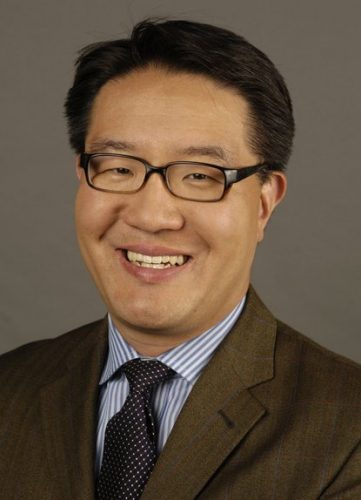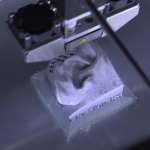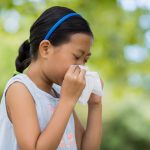Many industries are navigating the stress and aftershocks of the COVID-19 pandemic, and performance arts has taken a devastating hit. According to a national panel convened of representatives from choral associations, all performance groups from children’s choirs to professional ensembles are being warned that they may have to remain silent for the foreseeable future until there is a vaccine and effective treatment.
Phillip C. Song, MD, director of the Division of Laryngology at Mass. Eye and Ear, was recently featured on the WGBH “In It Together” segment with Arun Rath to comment on the changing landscape and new roadblocks for singers during the pandemic. Dr. Song, who has treated professional singers in his practice, answered some questions that many group singers and performers may have during this unprecedented time. You may listen to the full interview here.
Experts are warning singers that there is no way to safely rehearse and perform live at this time, is that true?
Singers are at high risk for transmission for COVID-19, because of the amount of aerosols they have the potential to generate. That poses an extremely difficult problem in regards to group rehearsals, and since there are real-world examples of people transmitting the disease in choir practices, it’s really hard to think of a way that groups could safely perform and sing together currently.
So, having the best masks and the best air circulation wouldn’t even do the trick?
It has a lot to do with how aerosols are generated in the lungs. It seems that the smaller areas of the lungs are actually responsible for smaller particles, and therefore they disperse more widely. Because singers are vocal athletes and they engage in diaphragmatic breathing, they can actually generate much more aerosols which can spread further. When people look at coughing for instance, even though coughing can produce droplets that are visible and can transmit disease, these droplets settle much more quickly than smaller particles that are generated from higher vocal tasks – speaking, yelling or singing. I think it would be difficult to sing with a mask on, especially with an N-95 or something that occlusive.
Vocal coaches often encourage others to sing from the diaphragm and project the voice, would that be dangerous advice now in terms of virus transmission?
It’s a catch-22: the characteristics that makes someone an effective singer are also traits that makes someone an effective aerosol generator. Physiologically, singing increases air speed and lung pressure, which will produce more aerosols. It could be that well-trained singers are at a higher risk of transmission of aerosols – louder singers are probably generating more aerosols than quieter voices. Choral singing is especially dangerous, for example the Mount Vernon choir in Washington recently had an outbreak where 87 percent of the choir was infected which resulted in two deaths. It was a tremendous lesson and that real world case is a far more effective demonstration than any laboratory test.
What advice would you give to choral and performance groups who want to continue rehearsing and singing together?
For now, practicing in a virtual setting is probably for the best. We have to start thinking about different ways of practicing and rehearsing, gathering together in a limited fashion with contact tracing, contact precautions and pre-screening or testing– this may offer some mitigation. There may be workarounds, and we have to accept some level of risk. I don’t agree with a blanket statement that you can’t sing over the next year until there is a vaccine, but it has to be done very safely and cautiously. Physical distancing, masks, and contact precautions are extremely important. In terms of live venue events, we’re not there yet, but the landscape is changing very quickly – even at Mass. Eye and Ear. The testing is continuing to get better and so is our ability to screen patients. As the technology and screening processes improve, there is certainly hope for singers in the future.
Download Dr. Song’s interview in a Podcast.
 About Our Expert
About Our Expert
Phillip C. Song, MD is the division director of Laryngology at Mass. Eye and Ear and a board-certified otolaryngology–head and neck surgeon who specializes in laryngology, voice and swallowing disorders, and neurolaryngology. He sees patients at the Mass. Eye and Ear, Main Campus in Boston.




Pingback: Dr. Anthony Fauci: To keep churches safe, use masks, limit singing and wait to resume Communion - Catholic Mass Search
Hello Dr. Song,
I am a classical singer and professor in New Orleans, exploring new protocols for vocal study and performance. We are planning on virtual lessons in the fall, but looking for outdoor solutions to performances. We are exploring face shields and distancing; would something like a tall, clear 10 ft screen in front of a singer be able to prevent aerosols from traveling to distanced Audience members?
What’s the opinion on one on one lessons and wearing protective gear? Is the risk any less or greater, even with keeping the 6 feet distancing as recommended? I ask because I am a voice teacher and I have several students that want to return to in person lessons and even though I have highly encouraged them to be patient, they are still insistent. I have mentioned to them the recent reports regarding singing in groups but if I can get some feedback regarding this particular situation, I would greatly appreciate it.
Hi Roberto,
From Dr. Song: There has been a lot of questions regarding the use of physical barriers such as shields and screens, while these may provide some droplet protection, aerosols are generally much harder to control and predict as they are highly dependent on environmental conditions, air flow (direction, velocity, and volume), circulation, filtration etc… frankly, these issues have not been well studied and are highly variable.
In our clinics when there is the potential to generate aerosols during our procedures and assessments for voicing and singing, we have been using “enhanced” respiratory protection which involves an N95 mask, clear plastic face screen, gown, and gloves in an examination room that circulates air turnover 6 times per hour. This is in addition to careful screening for symptoms and appropriate COVID testing. Although the risk will never be zero, institutionally, this practice has been decided to be the best we have for reducing transmission. These practices are continuing to evolve over time and will likely be altered as we learn more about the virus.
While I believe in caution when there is an outbreak of any disease, there is also a need for common sense. If in any other given season that involves colds, bronchitis, various forms of influenza, and other conditions or diseases transmitted via viruses, no one bats an eye. We take our cold medications, stay away from sugar, rest, drink plenty of fluids, and take advantage of all kinds of over-the-counter medications or home remedies we know work for us. If we get sick, we take advantage of our contacts with the medical profession. Where affordable and feasable, we make appointments and seek stronger means of reaching full health once again.
I’ve been a life-long musician and have sung for 58 years. Never have I as a singer been focused on as a greater carrier of virally-transmitted diseases as opposed to the greater population. What about folks who yell at sporting events? Or professional wrestlers who make all kinds of vocalizations? Singers are not the only sub-group that use athletic breathing and projection of their voices in order to conduct their profession.
Dr. Song’s projectile hypothesis should extend to any person or profession in which an individual must raise their voice, sung or spoken, above normal conversational tone and volume.
I also find it intriguing that during 2019 we had many thousands of Americans who died from influenza. Never did any discussion arise about us needing to quarantine, wear masks, stay home from work if ill, or any other parameters suddenly in place for Covid-19. Yet we blink and accept the deaths as a part of the rhythm of life.
As a musician who thrives on being a thinker and doing the right thing, I’ve worn my mask while out in public for any reason. However, I find the more disconcerting scenario are all the other humans I encounter who do not follow guidelines for PPE, acting as if there is no pandemic in progress. I’ve also transitioned into virtual teaching, virtual choir development, and even done work from home.
I would love to hear that a more reliable testing for Covid-19 might soon be available. The latest research I’ve done is that none of the tests now ready for use, or ones that have been in use, are not fully reliable. Without the assurance of reliable testing and a vaccine that would mitigate the pandemic and drive down the number of people who are actually ill, we singers could be in for a really dry spell, both economically and professionally.
Hi Dr. Song,
I wonder if wearing face shields would be better than wearing masks, enabling the resumption of choral singing, in particular at church services. I am very discouraged by this situation and am hoping for some kind of solution.
Hi Maroush, thanks for your comment. From Dr. Song: There has been a lot of questions regarding the use of physical barriers such as shields and screens, while these may provide some droplet protection, aerosols are generally much harder to control and predict as they are highly dependent on environmental conditions, air flow (direction, velocity, and volume), circulation, filtration etc… frankly, these issues have not been well studied and are highly variable.
Are there any examples of singing being a super-spreader event when social distancing and masks are being worn? All the references seem to be to a couple of lengthy choir practices with no masks, no social distancing, and close contact.
Hi Mark, thanks for reading and your question. Unfortunately there is not published research to our knowledge. As Dr. Song said in an earlier comment, “there have been a lot of questions regarding the use of physical barriers such as shields and screens, while these may provide some droplet protection, aerosols are generally much harder to control and predict as they are highly dependent on environmental conditions, air flow (direction, velocity, and volume), circulation, filtration etc… These issues have not been well studied and are highly variable.”
As a life long International Singer, I continue to sing scales alone and sing alone with a CD orchestra. I have lung disease and I am going to wait for the vaccine, as hard as that will be.! Do you agree.?Thank you for your time!
Matilda Stoddard
Hello Dr. Song, thank you so much for this valuable information. I am a voice coach in the professional theatre and as you might imagine I’ve been reading a lot to try to find answers about how to move forward during Covid19. I appreciate that you are basing your assessment fully on science, and at the same time making the science understandable for those of us that are singers and actors, not doctors. again, many thanks! Patricia Delorey
Thank you for reading and sharing your comment, Patricia. We really appreciate it and passed along to Dr. Song!
Hello!
I went to an outdoor theater preview in Ashfield last Saturday. Several times the unmasked actors sang to us. We, the audience, all had masks on. We sat on benches in front of the actors at six different spaces. The front benches (only 10 people were in each audience group) were about 15 feet from the audience. Is that far enough? What would be far enough? At one point, about eight robust men sang directly to the audience in an Odyssey scene. I backed away and hid around a corner of a building so their aerosols would not hit me. In another scene, we walked into a fenced-in area the size of a large kitchen and a woman sang to us (I hung behind on the path). This was a preview and there will be other shows. Any advice you’d have to make this safer? I think they should wear masks, aim their singing away from the audience and move the benches back. Many of the audience members are over 70. Thank you!
Dear Dr. Song,
I am a high school choral director. Is humming any more dangerous that speaking while wearing a mask?
Hi, thanks for reading. There is unfortunately no data on this at this time to definitively comment on humming and risk for transmission.
Pingback: Super Spreader?
Do you have any data or opinion on singing outdoors, with or without masks?
Hi Peter, thanks for reading. There is no published data we’ve come across but will sure to update if we find any news.
Hi Dr. Song,
I am a professional singer and voice teacher in the Orlando area. What are your thoughts on the Broadway Relief “Singer’s Mask?” It was created by singers to help contain droplets, but allow more room to sing. How do you think it compares to a regular mask and do you think it is safe to use for singing?
Pingback: How Can I Keep from Singing? | Laurie Haller
Dr. Song,
Thank you for this informative article. I am a member of a 38-voice ensemble from Central PA. Our Artistic Director is hoping to start rehearsals very soon and we are searching for science-based studies to guide us regarding safe ways to do so. Information regarding masks, spacing, ventilation, length of rehearsal, singer waivers, etc. would be greatly appreciated.
Hello Dr. Song,
I am a music teacher and have been told that in order to allow my students to sing indoors, that we must order and use surgical masks instead of allowing them to use their already in-place masks. Everything I’ve read from the CDC to NAfME guidelines say not to do so. What is your expert opinion? Can we sing indoors with a regular cloth mask?
So, March 2, 2021 are there any updates on recommendations for potential indoor and congregational singing with masks and social distancing that should be adhered to with combinations of vaccinated and unvaccinated participants?